

|
Sketch of Nevil Shute Norway in flying kit by Flora Twort. The original work is held by copyright by Petersfield Museum (curator@petersfieldmuseum.co.uk) from whom permission is required for reproduction. |
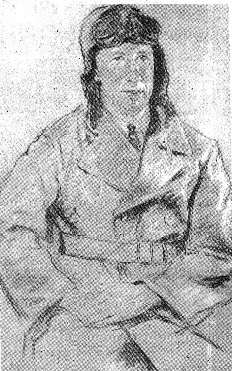
|
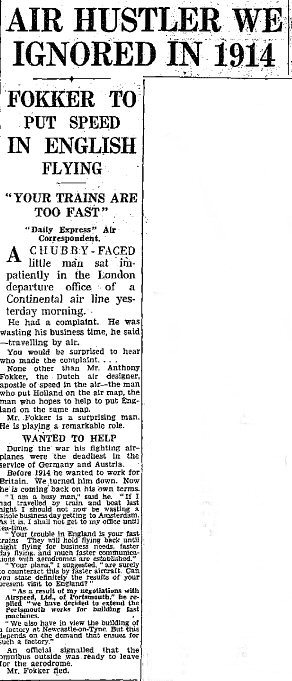
|
As this is a bit difficult to read, here is a transcript:- "YOUR TRAINS ARE TOO FAST"
A CHUBBY FACED little man sat impatiently in the London departure office of a Continental air line yesterday morning.Daily Express Air Correspondent. He had a complaint. He was wasting his business time, he said, travelling by air. You would be surprised to hear who made the complaint. None other than Mr Anthony Fokker, the Dutch air designer, apostle of speed in the air, the man who put Holland on the air map, the man who hopes to help to put England on the same map. Mr Fokker is a surprising man. He Is playing a remarkable role. WANTED TO HELP
During the war his fighting air planes were the deadliest In the service of Germany and Austria.
Before 1914, he wanted to work for Britain. We turned him down. Now he is coming back on his own terms. "I am a busy man," said he," If I had travelled by train and boat last night I should not now be wasting a whole business day getting to Amsterdam. As it is, I shall not get to my office until tea-time." "Your trouble in England is your fast trains. They will hold flying back until night flying for business needs, faster day flying. and much faster communications with aerodromes are established." "Your plans," I suggested "are surely to counteract this by faster aircraft. Can you state definitely the results of your present visit to England ?" "As a result of my negotiations with Airspeed, Ltd., of Portsmouth," he replied, "we have decided to extend the Portsmouth works for building faster machines. "We also have in view the building of a factory at Newcastle-on-Tyne, but this depends on the demand that ensues for such a factory." An official signalled that the omnibus outside was ready to leave from the aerodrome. Mr. Fokker fled. |
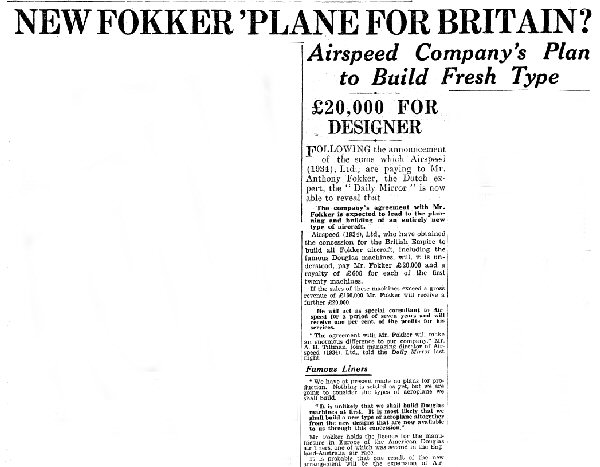
|
Text is as folows:- FOLLOWING the announcement of the sums which Airspeed (1934) Ltd., are paying to Mr. Anthony Fokker, the Dutch expert, the "Daily Mirror" is now able to reveal that the company's agreement with Mr. Fokker is expected to lead to the planning and building of an entirely new type of aircraft. Airspeed (1934), Ltd., who have obtained the concession for the British Empire to build all Fokker aircraft, including the famous Douglas machines, will, it is understood, pay Mr. Fokker £20,000 and a royalty of £600 for each of the first twenty machines. If the sales of these machines exceed a gross revenue of £150,000 Mr. Fokker will receive a further £20,000. He will act as special consultant to Airspeed for a period of seven years and will receive one per cent of the profits for his services. "The agreement with Mr.Fokker will make an enormous difference to our company," Mr. A. H. Tiltman, joint managing director of Airspeed (1934) Ltd, told the Daily Mirror last night. "We have at present made no plans tor production. Nothing is settled as yet, but we are going to consider the types of aeroplane we shall build." "It is unlikely that we shall build Douglas machines at first. It is most likely that we shall build a new type of aeroplane altogether from the new designs that are now available to us through this concession." Mr Fokker holds the licence for the manufacture in Europe of the American Douglas air liners, one of which was second in the England-Australia air race. It is probable that one result of the new arrangement will be the expansion of Airspeed's Portsmouth works. |
Daughter Shirley Anne is born to Nevil and Frances Shute. Artist friend Flora Twort is made her Godmother.
Travelling in a train with Airspeed's publicist Concord Morton, Shute discusses a cutting from The Times about the crash of the new, all metal, Boeing 247 airliner. The aircraft's tail had fallen off. In 1948 Shute publishes No Highway in which tailplane metal fatigue causes the crash of a new airliner.
Shute spends 3 weeks in Athens trying unsuccessfully to sell aeroplanes. This experience becomes inspiration for Ruined City.
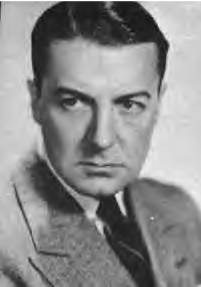
In 1936 Shute visits Ealing Studios, near his birthplace, to see his favourite actor, Clive Brook (1887-1974), film Lonely Road. Also released as Scotland Yard Commands it was produced by Basil Dean and directed by James Flood. It starred Clive Brook and Victoria Hopper. Shute had written the book with Clive Brook in mind and had, on publication, sent him a copy. ( OU ) |
||
1936:The Courier becomes the first aeroplane ever to receive television signals in flight when used for TV transmission testing. |
||
1936:Shute begins writing Ruined City. |
||
March 1936:Airspeed now employs 600 people. |
||
May 1936:Airspeed designs the Queen Wasp target plane. |
||
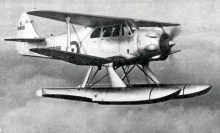
In May 1936 Airspeed gets an order for the prototype Queen Wasp Radio Controlled Target Plane. It cruises at 151mph (243 kph) with a top speed of 173mph (277kph) and carries one pilot for ferrying. ( DHM ) Click for larger image |
||
July 17 1936Spanish Civil War starts. All the unsold Airspeed aeroplanes are quickly sold. The war finally ends on April 01 1939. |
||
1936Joseph Smith (27) and Arthur Gargett (22), employees of Airspeed, steal G-ACVA, a new Courier worth £3,400, to make their fortune in the Spanish Civil War. They crash on take-off. Gargett dies and Smith receives 4 months in prison. Young Airspeed employee Henry Cutting innocently assists them and in 2003 still remembers the crash vividly. Shute gave evidence at the trial. A cutting from the Daily Mirror of Friday 21 August 1936 reported the event.  |
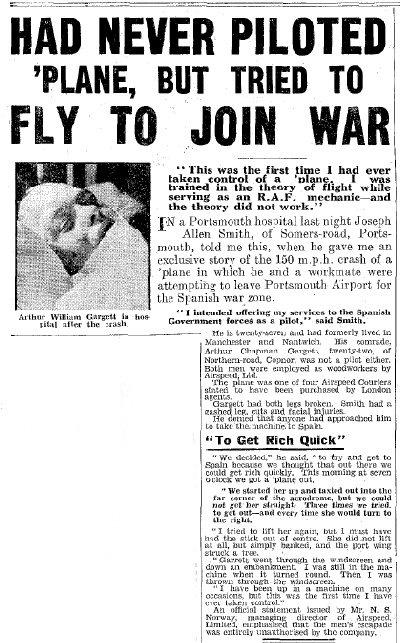 |
|
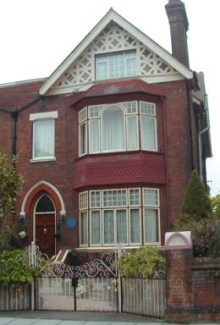
The Shute family live at 14 Helena Rd Southsea from 1936 to late 1939. (Photo: AB 2002) |
||
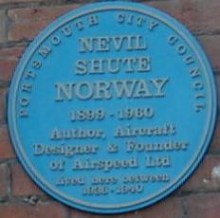
The slightly incorrect plaque at 14 Helena Rd Southsea. It reads "Portsmouth City Council. Nevil Shute Norway 1899 - 1960 Author, Aircraft Designer & Founder of Airspeed Ltd Lived here between 1936 - 1940". The family moved out in late 1939 to avoid stray bombs aimed at Portsmouth. (Photo: DDT 2002) |
||
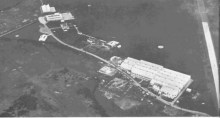
The enlarged Airspeed factory at Portsmouth Aerodrome is seen here in September 1936. Note the beginnings of further buildings on the other side of the road. (Photo: FM / DHM / DH ) Click for larger image |
||
|
Early April 1933: Henry Cutting, an office boy at Airspeed, recalled in 2003 that a man working on Cobhams refuelling experiments was in a fight outside Mother Shiptons Pub. The other man in the fight died. Cobhams partner was allowed free before his trial but died when his plane, GABXN, crashed in Portsmouth Harbour on April 15 1933. In late 1945 Shute used the plot point of a fatal pub fight in The Chequer Board. |
||
|
Between 1933 and 1938 In 2003 Henry Cutting recalled that in the Airspeed factory a fuel tank was mistakenly tested with petrol instead of paraffin resulting in a large explosion and fire. Airspeed worker Andie Drummond died and co-worker George Lister was injured. Shute appeared, coolly stepping through the burning sacking that was used as a saw-dust barrier, and quickly took charge of the scene. |
||
|
October 04 1936: Airspeed 1934 Ltd files for a patent titled "Improvements in or relating to Indicating or Recording Instruments for use on Aircraft". It is for an instrument to measure air density to get the best possible performance out of an aircraft. |
||
|
October 1936 The Air Ministry orders the first 136 Envoy Trainers. These are later known as Airspeed Oxfords. |
||
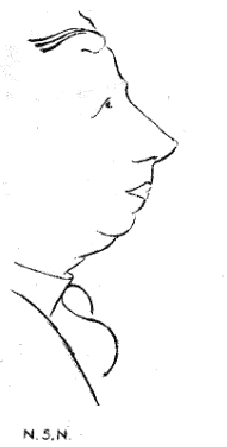
This caricature of Shute is from the Airspeed Gazette, the company magazine. (PL / Copyright © BAE SYSTEMS PLC) |
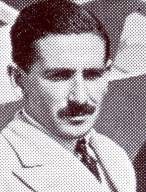
On January 27 1937 Shute entrusts his wife, Frances, to the flying skills of Airspeed's Test Pilot, Flt Lt Colman. Frances travels with him as far as Calcutta in Envoy G-AERT which is en route to be sold in China. (Photo: FM / SR ) |
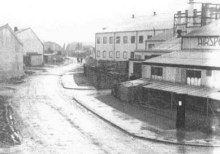 Click for larger image
Click for larger image
This is the Airspeed factory at Portsmouth. It is after 1936 as there are now buildings south of Airport Service Road. We are looking west on Airport Service Road with Bilton Way, in the immediate foreground, heading off to the right at the petrol pump or pillar box. ( AT ) |
March 1937The King's Flight Envoy is ordered. Shute starts to lose interest in Airspeed. |
 Click for larger image
Click for larger image
In The Kings Flight colours of red, royal blue and silver, the 1937 Royal Airspeed Envoy G-AEXX cruises at 181mph (290kph) and has a top speed of 211mph. (338kph) The Envoy could carry one pilot and six passengers. (Photo: TA / DHM / DH ) |